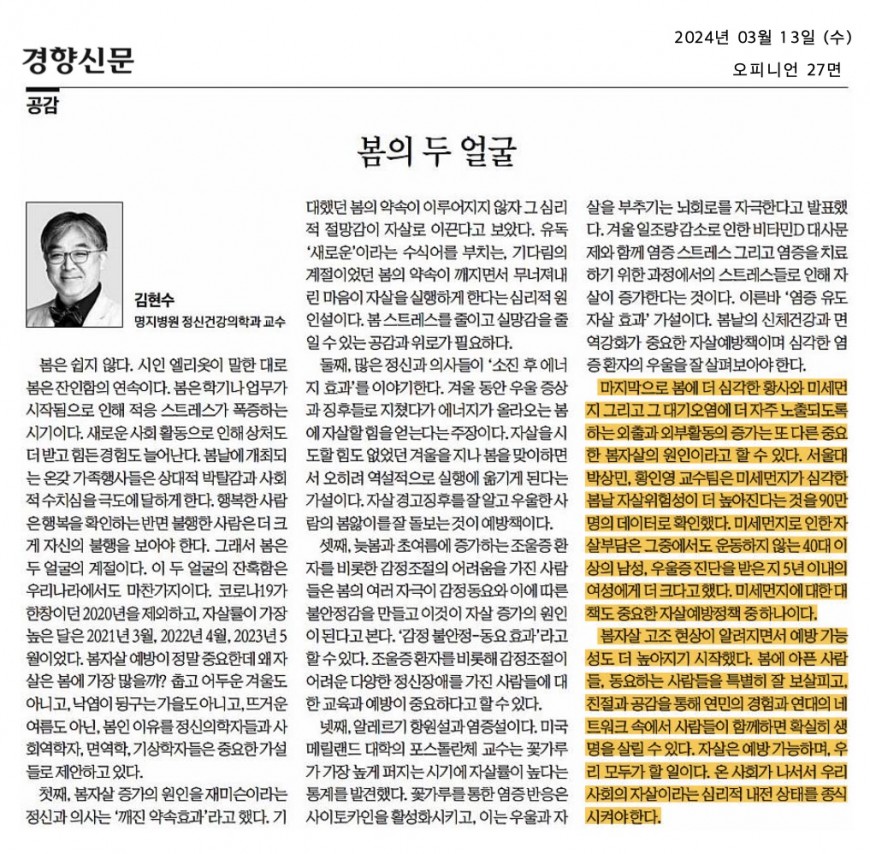[경향 20240312] 봄의 두 얼굴
꽃피고 따스한 봄을 기다리는데 이런 일도 있네요.
한국인의 사망원인에 자살은 매우 높은 순위를 차지 합니다.
불청객 등으로 표현되는 대기오염과 환경오염이 봄꽃을 헤집고 사람의 마음도 헤집나 봅니다.
각자 개인운동과 사회운동 열심히 하면서 즐거운 봄을 맞이 합시다~
 I'm waiting for the blooming and warm spring, and this is also happening.
I'm waiting for the blooming and warm spring, and this is also happening.
Suicide ranks very high as the cause of death for Koreans.
Air pollution and environmental pollution, expressed as uninvited guests, seem to be wading through spring flowers and wading through people's minds.
Let's have a fun spring while working hard on individual and social workouts
Two faced of Spring
Medical doctor of psychiatry KIM Hyun-Soo
translated by Papago
Spring is not easy. As poet Eliot put it, it is a series of brutality. Spring is a time when adaptation stress explodes due to the start of a semester or work. New social activities can lead to more injuries and more difficult experiences. All kinds of family events that take place on spring days lead to extreme feelings of relative deprivation and social shame. Happy people affirm their happiness, while those who are unhappy must see their own misfortune more broadly. So spring is a two-faced season. The same is true of these two-faced brutalities in our country. Aside from 2020, during the height of the COVID-19 pandemic, the months with the highest suicide rates were March 2021, April 2022, and May 2023. When prevention of spring suicides is really important, why are there the most suicides in spring? Psychiatrists, social epidemiologists, immunologists, and meteorologists have suggested important hypotheses why spring is when it is not a cold, dark winter, or a larch, but not a fall or a hot summer.
First, a psychiatrist named Jamieson called the 'broken promise effect' as the cause of the increase in spring suicide. When the expected promise of spring was not fulfilled, it was considered that the psychological despair led to suicide. It is a psychological cause theory that the collapsed mind leads to suicide when the promise of spring, the season of waiting, is broken, which gives the modifier 'new'. Empathy and comfort are needed to reduce spring stress and disappointment.
Second, many psychiatrists talk about the 'energy effect after exhaustion'. It is argued that they get the strength to commit suicide in the spring when their energy comes up after being exhausted from depression and signs during the winter. It is a hypothesis that paradoxically, as we face spring after winter when we had no energy to attempt suicide. The preventive measure is to know the signs of suicide warning and take good care of the spring pain of a depressed person.
Third, people with difficulties in controlling their emotions, including bipolar patients who increase in late spring and early summer, believe that various stimuli in spring create emotional agitation and instability, which causes an increase in suicide. It can be called 'emotional instability-charming effect'. It can be said that education and prevention of people with various mental disorders who have difficulty controlling their emotions, including bipolar patients, are important.
Fourth, the allergic antigen theory and the inflammation theory. Professor Postolanche of the University of Maryland in the United States found statistics that the suicide rate was high when pollen was spreading the highest. It was announced that the inflammatory response through pollen activates cytokines, which stimulates brain circuits that encourage depression and suicide. Suicide increases due to vitamin D metabolism problems caused by a decrease in winter sunlight, inflammatory stress, and stress in the process of treating inflammation. It is the so-called 'inflammatory induced suicide effect' hypothesis. Strengthening physical health and immunity in spring is an important suicide prevention measure, and depression in patients with severe inflammation should be carefully examined.
Lastly, the increase in going out and outside activities, which allow more frequent exposure to more severe yellow dust, fine dust, and air pollution in spring, is another important cause of suicide in spring. A team led by professors Park Sang-min and Hwang In-young of Seoul National University confirmed with data from 900,000 people that the risk of suicide is higher on a spring day when fine dust is severe. The burden of suicide due to fine dust is greater for men in their 40s or older who do not exercise and women within five years of being diagnosed with depression. Countermeasures against fine dust are also important suicide prevention policies.
As the spring suicide escalation became known, the likelihood of prevention began to increase. People who are sick and agitated in the spring are especially well cared for, and through kindness and empathy, people can certainly save their lives when they are together in a network of compassion experiences and solidarity. Suicide is preventable and something we all should do. The whole society must step up and end the psychological civil war of suicide in our society.



